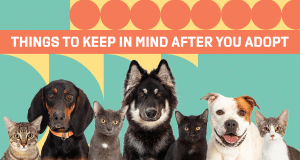
Dental Services Available
September 18, 2022
Home for the Holidays: Giving Pets as Holiday Gifts
December 19, 2022
Life is full of milestones. Whether it’s a big life event or simply accomplishing a long sought goal, these special moments help give our lives meaning and joy. Adopting animals and making them part of your family is one of those moments in life that change us forever. We at the Tulsa SPCA have been thrilled to assist in over 1,000 adoptions so far this year! Seeing the joy on the faces of those who adopt, paired with the glee the animals express when they know they have found their forever homes, never gets old. We are also aware that this is the beginning of a brand new chapter, and we are committed to helping you in easing the transition from the Tulsa SPCA to your home. My name is Kyle Paddock, the Director of Communications. I spoke with Lauren Holder, our Animal Connections Manager, who gave some great advice on what to do during those first few weeks.
“I will start with cats. With cats, a good thing to do immediately is confine them to a room (laundry room, spare room, or bathroom) with supplies for the first few days, maybe even up to a week depending on how well the animal is adjusting. Slow introductions with resident animals is also key—an adult cat shouldn’t be meeting your other pets on the first day. Slow intros can be achieved by separating animals and allowing them to sniff each other under the door, placing one in a crate/carrier and letting them sniff each other, or by keeping separated any time the human cannot be there to supervise them for the first few weeks.”
This is fantastic! What about dogs?
“With dogs, be sure to walk your fence line to check for holes prior to bringing a dog home. A new dog should only be leash walked even in a fenced yard for the first few days. Do not allow a new dog to be unsupervised even in a fenced yard for several weeks post-adoption. Introductions to resident dogs should take place on neutral territory (ex: a public park, a neighborhood walk). Keep collar & ID tags on the dog just in case they get spooked and get lost. Do not try to take food or toys from dogs/puppies; always trade items up instead. For example, if a dog is eating its dog food and the human wants them to stop, the human needs to offer the dog something better than dog food like a treat or a piece of human food. Otherwise, the human is only teaching the dog to resource guard their possessions. Do not invite a bunch of people over the first few weeks. Allow the dog time to adjust to their new home and humans. If this cannot be avoided, crate the dog and/or keep in separate room. Always crate the puppy/dog when you cannot supervise them as new environments can be very stressful & this will help keep them safe & human possessions protected.”
Lauren, thanks for sitting down with me today! I’m confident that this information will be of great help to our readers. If there was one thing you would want our readers to take away from this article, what would that be?
“I think it would be nice just to remind people this is a big transition for an animal and that not eating or the animal hiding initially is completely normal. Sometimes people freak out over this stuff and want to return them, but they can always reach out to us for help. They are not alone in this process.”
Finally, if an animal that you adopted from us gets lost, don’t panic! There are some things that you can do straight away to maximize the chances of finding your furry friend:
- We recommend using Nextdoor, a neighborhood-based app for finding lost animals. Simply input the details of your pet in the post and your local neighborhood will be on the lookout.
- There are several lost and found pet groups on Facebook that are also community/neighborhood specific. Posting there as well is also recommended.
- Post on your personal social media pages and call us to let us know that your pet is missing.
- All animals adopted from us are microchipped. We highly recommend contacting the microchipping company after adoption to be sure the information is updated. In the case that your pet goes missing, that information can prove extremely useful in returning them to you.
- Finally, be sure to contact us with pertinent information about your lost pet, such as color of the collar, last location seen, a physical description, etc. so that we can post on the Tulsa SPCA’s social media channels.
We hope you have found this article helpful! At the Tulsa SPCA, our mission as always is to improve the lives of dogs and cats, and their human companions. Reach out to adoptions@tulsaspca.org today if you have any further questions!


